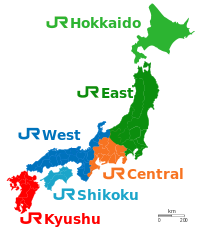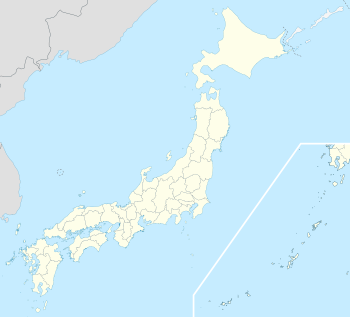Japan Railways Group


The Japan Railways Group, more commonly known as the JR Group (JRグループ, Jeiāru Gurūpu) or simply JR, is a group of railway companies in Japan that underwent division and privatization[1] of the government-owned Japanese National Railways (JNR) on April 1, 1987. It consists of six passenger railway companies, one freight railway company, and two non-service companies. Most of the liability of the JNR was assumed by the JNR Settlement Corporation.
The JR Group operates a large proportion of intercity rail service (including the Shinkansen high-speed rail lines) and commuter rail service.
JR Hokkaido, JR Shikoku, and JR Freight (JRF) are governed by the Act for the Passenger Railway Companies and Japan Freight Railway Company[2], also known as the JR Companies Act, and are under the control of the public Japan Railway Construction, Transport and Technology Agency (JRTT), while JR East, JR Central, JR West, and JR Kyushu are completely floated in the stock market; in addition, JR East, JR Central and JR West are constituents of the Nikkei 225 and TOPIX 100 indices. Because the railways used to be owned by the government, Japanese people generally make a distinction between JR railways (including former JR lines that are now third sector) and other private railways, and JR railways are almost always denoted differently from other private railways when shown on maps.[3]
Background
[edit]



By the 1970s, passenger and freight business had declined, and fare increases had failed to keep up with higher labor costs.[4]
The JR Group companies were formed out of the privatization of the Japanese National Railways in 1987.[5][6]
Ownership
[edit]
In 1987, the government of Japan took steps to divide and privatize JNR. While division of operations began in April of that year, privatization was not immediate: initially, the government retained ownership of the companies. Privatization of some of the companies began in the early 1990s. By October 2016, all of the shares of JR East, JR Central, JR West and JR Kyushu had been offered to the market and they are now publicly traded. On the other hand, all of the shares of JR Hokkaido, JR Shikoku and JR Freight are still owned by Japan Railway Construction, Transport and Technology Agency, an independent administrative institution of the state.
All the JR Group companies operating in the Honshū region are constituents of the Nikkei 225 and TOPIX 100 indexes.
Companies
[edit](JR Freight, JRTT, and JR Systems are omitted)
The Japan Railways Group consists of seven operating companies and two other companies that do not provide rail service. The operating companies are organized into six passenger operators and a nationwide freight operator. Unlike some other groups of companies, the JR Group is made up of independent companies, and it does not have group headquarters or a holding company to set the overall business policy.
The six passenger railways of the JR Group are separated by region. Nearly all their services are within the prescribed geographic area. However, some long-distance operations extend beyond the boundaries. The Shirasagi train service between Nagoya and Kanazawa, for instance, uses JR West rolling stock but the segment of track between Nagoya and Maibara is owned by JR Central, whose crew manage the train on that section.
Japan Freight Railway Company operates all freight service on the network previously owned by JNR.
In addition, the group includes two non-operating companies. These are the Railway Technical Research Institute and Railway Information Systems Co., Ltd.
To cover various non-railway business areas, each regional operator in the JR Group has its own group of subsidiary companies with names like "JR East Group" and "JR Shikoku Group."
| Business | Logo and color | Company | Type | Traded as | Region(s) of operation | Note |
|---|---|---|---|---|---|---|
| Passenger | Grass |
Hokkaido Railway Company (JR Hokkaido) | Kabushiki gaisha | Not listed
Owned by JRTT |
Hokkaidō | operates Hokkaidō Shinkansen in Hokkaido |
Forest |
East Japan Railway Company (JR East) |
|
Tōhoku, Kantō, Hokuriku, Kōshin'etsu | operates Tōhoku Shinkansen, Yamagata Shinkansen, Akita Shinkansen, Jōetsu Shinkansen and Hokuriku Shinkansen (with JR West) | ||
Pumpkin |
Central Japan Railway Company (JR Central) | Chūbu (including Tōkai, its Japanese eponym) | operates Tōkaidō Shinkansen in Kantō and Kansai | |||
Ocean |
West Japan Railway Company (JR West) |
|
Hokuriku, Kansai, Chūgoku, Kyūshū | operates Sanyō Shinkansen in Kansai, Chūgoku and Kyushu and Hokuriku Shinkansen (with JR East) in Hokuriku | ||
Sky |
Shikoku Railway Company (JR Shikoku) | Not listed
Owned by JRTT |
Shikoku | |||
Scarlet |
Kyushu Railway Company (JR Kyushu) | Kyūshū | operates Kyūshū Shinkansen in Kyūshū | |||
| Freight | Slate |
Japan Freight Railway Company (JR Freight) | Not listed
Owned by JRTT |
Nationwide | ||
| IT Services | Burgundy |
Railway Information Systems Co., Ltd. (JR Systems) | Not listed
Owned by the 7 railway companies above[7] |
Nationwide | develops, operates and manages computer systems, including MARS (ticket reservation system)[8] | |
| Research & Development | Lavender |
Railway Technical Research Institute (RTRI) | Kōeki zaidan hōjin | A non-profit organization funded by the 7 railway companies above[9] | Nationwide | conducts research and development of railway-related technologies, such as SCMaglev[9] |
Network
[edit]JR maintains a nationwide railway network as well as common ticketing rules that it inherited from JNR. Passengers may travel across several JR companies without changing trains and without purchasing separate tickets. However, trains running across the boundaries of JR companies have been reduced.
JR maintains the same ticketing rules based on the JNR rules and has an integrated reservation system known as MARS (jointly developed with Hitachi). Some types of tickets (passes), such as Japan Rail Pass and Seishun 18 Ticket, are issued as "valid for all JR lines" and accepted by all passenger JR companies.
Unions
[edit]Various unions represent workers at the different JR Group companies, such as the National Railway Workers' Union, All Japan Construction, Transport and General Workers' Union, Doro-Chiba, and the Japan Confederation of Railway Workers' Unions.
See also
[edit]- Rail transport in Japan
- List of railway companies in Japan
- Japan Railways locomotive numbering and classification
- SoftBank Telecom – former Japan Telecom, an affiliated company of JNR established in 1984
References
[edit]- ^ See Japanese National Railways division and privatization.
- ^ 旅客鉄道株式会社及び日本貨物鉄道株式会社に関する法律, Ryokaku Tetsudō kabushiki gaisha oyobi Nippon Kamotsu Tetsudō kabushiki gaisha ni kan-suru hōritsu, Act No. 88 of December 4, 1986
- ^ http://www.jreast.co.jp/renrakuteiki/index.html Archived 2016-04-06 at the Wayback Machine Using Suica Railway Pass, connect from JR to Private Rail/Metro!
- ^ "The Annual Report of Transport Economy(1975) - Chapter 4 Reconstruction of Japanese National Railways". Ministry of Transport. Retrieved 2003-04-23.
- ^ Kasai, Yoshiyuki (2021-10-25). Japanese National Railways – Its Break-up and Privatization: How Japan's Passenger Rail Services Became the Envy of the World. BRILL. ISBN 978-90-04-21397-5.
- ^ Imashiro, Mitsuhide; Ishikawa, Tatsujiro (2013-12-17). The Privatisation of Japanese National Railways: Railway Management, Market and Policy. A&C Black. ISBN 978-1-78093-929-2.
- ^ "Corporate Overview - JR RAILWAY INFORMATION SYSTEMS CO.,LTD". www.jrs.co.jp. Retrieved 2023-12-05.
- ^ "Products and Solutions - JR RAILWAY INFORMATION SYSTEMS CO.,LTD". www.jrs.co.jp. Retrieved 2023-12-05.
- ^ a b "Railway Technical Research Institute". Railway Technical Research Institute. Retrieved 2023-12-05.
 This article incorporates text from this source, which is in the public domain. Country Studies. Federal Research Division. – Japan
This article incorporates text from this source, which is in the public domain. Country Studies. Federal Research Division. – Japan
External links
[edit]- Hisakyu's Railway Guide (archived 21 July 2009)
- JR's Rule on Passenger Tickets

